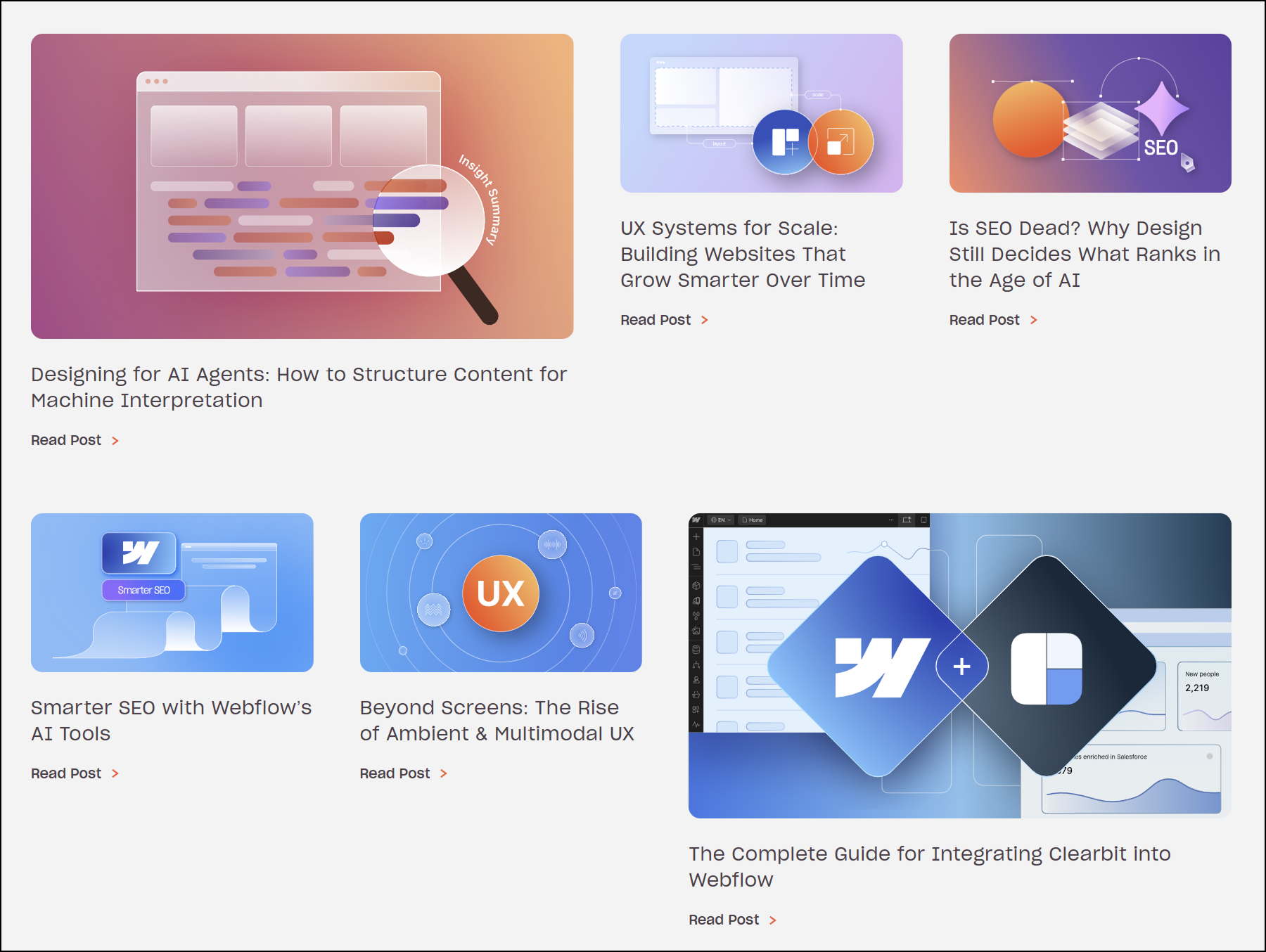AI assistants like ChatGPT, Perplexity, and Gemini are becoming their own discovery channels. They summarize businesses, compare products, surface recommendations, and answer questions that used to live in search results. The big shift is that AI doesn’t return ten blue links. It returns a single synthesized answer.
To be included in that answer, your brand needs to be understandable to the model and trustworthy enough for it to cite. That’s where a new mix of SEO, AEO, UX, and AX comes together. The strategies that worked for search engines aren’t the same ones that help AI systems interpret your site today.
Here are the ten most effective ways to increase your chances of being recommended, cited, or surfaced by AI agents.
1. Build Domain-Level Expertise (Not Just Good Pages)
AI assistants evaluate credibility at the domain level, not page by page. If you write one article about a topic, it may help with Google, but it won’t build enough confidence for AI systems to recommend you.
Models look for depth:
- Multiple posts reinforcing a subject
- FAQs answering nuanced questions
- Service pages that match your content
- Case studies that show lived experience
Depth creates a pattern, and patterns create trust.
This is one of the biggest differences between traditional SEO and AEO. You aren’t optimizing individual URLs. You’re creating a domain that AI agents can map and understand clearly.

2. Use Semantic HTML That Models Can Parse Easily
AI agents don’t “see” your layout. They see structure. They rely on proper headings, labeled components, and HTML that aligns with meaning, not aesthetics.
This looks like:
- Consistent H1 → H2 → H3 hierarchy helps models parse intent
- Clear labels help AI understand sections
- Readable HTML gives models fewer chances to misinterpret meaning
This is also why frameworks like Webflow, which output clean, predictable code, support AEO and AX better than bloated templates. It gives both search engines and AI assistants a clearer starting point.
Accessibility supports this layer too. Accessible elements like descriptive alt text, clear labels, and logical heading structures give AI agents more context to interpret. The same practices that help people with assistive technologies also help models map meaning more accurately. Read Accessible by Design: How AX and Accessibility Overlap for a deeper look.
3. Implement Clean, Consistent Schema Markup Across Your Site
Schema is now one of the strongest signals for credibility in the AI era. It translates your content into a machine-friendly format so agents can interpret what a page represents.
Apply schema to:
- Articles
- Case studies
- Services
- Team bios
- FAQs
- Product pages
Structured data doesn’t just support SEO. It directly strengthens how AI agents interpret your meaning, which increases your likelihood of being cited. For a detailed guide on generating and implementing schema markup in Webflow, read SEO for ChatGPT: Help LLMs Understand Your Website.
This is also where Webflow's new AI schema generator helps teams stay consistent across large sites. We explored this more in Smarter SEO with Webflow’s AI Tools.

4. Strengthen Author Transparency and Entity Clarity
AI systems weigh authorship more heavily than keywords. Clear bios, defined expertise, a real team page, and consistent entity information all help models assign authority to your content.
This is especially helpful for:
- Medical, legal, or financial topics
- Opinion-driven content
- How-to guides
If a model cannot determine who you are or why you’re qualified, it’s less likely to recommend you. Transparency is now part of credibility for humans and machines.
5. Use Internal Linking to Show How Your Content Connects
AI agents build “concept maps” of your domain. Internal linking is how you teach them what belongs together. When pages reference one another intentionally, you’re signaling depth and relationship.
Link:
- Posts to service pages
- Case studies to capabilities
- Articles to glossary terms
- Related topics to each other
Models interpret this like a knowledge graph. The clearer the graph, the easier it is for AI systems to recommend you with confidence.
6. Keep Content Fresh and Update It Consistently
Recency is one of the strongest signals for AI-driven discovery. Perplexity favors fresh content. Gemini leans toward recently updated sources. Even ChatGPT’s retrieval layer prioritizes content that changes predictably.
This doesn’t require a major rewrite. Small updates help:
- Refreshing examples
- Adding new data
- Reworking intros
- Adding internal links
Freshness tells AI that your knowledge is current, not abandoned.
7. Use Structured CMS Templates to Support Patterns
AI agents respond well to consistency. A CMS built around repeatable, predictable templates makes each piece of content more interpretable. It also increases the quality of your domain-level signals.
Templates help maintain consistent:
- Headings
- Metadata
- Schema
- Component structure
- Internal linking
- Content patterns
This is one of the big advantages of using a system like Webflow, especially for a Webflow agency in New York that builds large, content-driven ecosystems.

8. Be Explicit About What You Actually Do
Vague positioning is the enemy of AI interpretability. Models rely on explicit clarity: what you offer, who you serve, where you operate, and why you’re credible.
Strengthen clarity by making sure your:
- Hero copy states your value plainly
- Service pages say what you actually deliver
- Metadata matches the content
- CTAs reflect real outcomes
For example, a hero that says “We help brands grow” doesn’t teach AI, or people, anything. A clearer version like “We design and build websites used by millions that are easily updated and managed by internal marketing teams” gives both audiences the context they need.
Service pages should follow the same approach. “Full-service digital strategy” is vague. “UX design, Webflow development, and content strategy for product teams” is concrete.
Even CTAs benefit from clarity. “Learn more” is almost invisible to AI systems because it doesn’t signal intent. “See our Webflow case studies” gives models (and users) a clear action tied to a real outcome.
AI assistants penalize ambiguity because it increases the risk of an inaccurate recommendation. Explicit messaging helps AI agents feel confident citing you.

9. Earn Mentions From Reputable Sources
Backlinks matter less to AI agents than they do to Google, but mentions still matter. When your brand appears in reputable publications, industry articles, podcast summaries, or expert lists, AI systems store those associations as part of your entity profile.
You can influence this through:
- Guest posts
- Interviews
- Industry directories
- Thought leadership pieces
- Speaking engagements
- Citations from other experts
AI uses these mentions to triangulate who you are. They become trust signals at the domain level, not just the page level.
10. Create Content That Answers Niche, Specific Questions
AI assistants rely heavily on niche queries because they’re designed to produce precise, contextual answers. While broad topics help with traditional search, AI-driven discovery favors depth and specificity.
Great examples:
- How to migrate X to Y
- What’s the best way to configure Z
- When you should choose A vs B
- The difference between two similar tools
- Troubleshooting or configuration content
- Templates with clear use cases
You don’t need to chase trending keywords. You just need to answer the questions that your audience actually asks, in a way that AI can interpret easily.
Where AI Recommendations Are Heading Next
Being recommended by AI is not the same as ranking in traditional search. It requires structural clarity, domain-level expertise, semantic meaning, and consistency that appeal to both humans and machines. Your content must be understandable, your design must be legible, and your site architecture must make sense as a system. The brands that master this now will become the ones AI assistants trust, cite, and surface most often.
The next shift comes from agentic AI. Instead of users asking for recommendations and acting on them manually, AI agents have begun taking actions on their behalf. They may book discovery calls, compare service providers, schedule consultations, fill out initial intake forms, and make shortlists without the user ever visiting your website directly. In that world, clarity becomes more than a visibility strategy. It becomes an operational requirement.
If your site is easy for AI systems to interpret, it becomes easier for these agents to choose you automatically. If it is vague, inconsistent, or structurally confusing, you risk being filtered out long before a person enters the picture.
As discovery continues shifting toward AI, recommendations will become the new rankings, and actions will become the new conversions. The brands that win will be the ones designed not just to be read, but to be understood, by both humans and the agents acting on their behalf.




.svg)

.svg)











